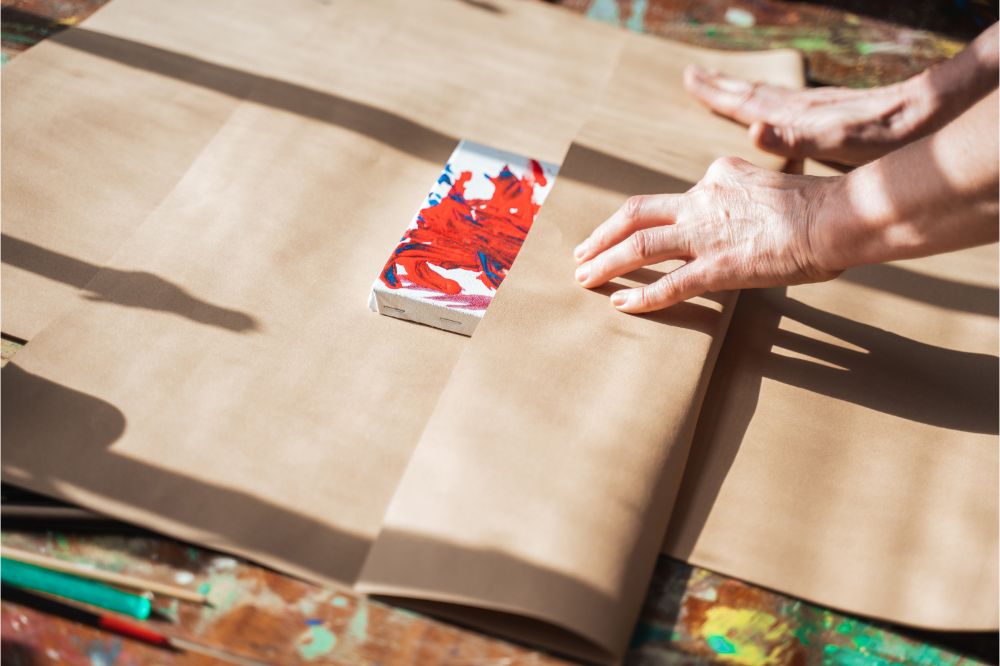Artwork and delicate paintings are precious and often hold significant value, both emotionally and financially. Whether you’re an artist, collector, or simply someone who appreciates art, ensuring the safe packaging and protection of these pieces is crucial during transportation or storage. In this blog, we will explore various creative ways to pack and protect artwork and delicate paintings, helping you safeguard these treasures and keep them in pristine condition.
Use Acid-Free Materials
When packing artwork, it’s essential to use acid-free materials to prevent any potential damage caused by acidic substances. Acid-free archival tissue paper is ideal for wrapping paintings and acts as a protective barrier against moisture and acidity. Additionally, acid-free cardboard or foam core boards should be used as backing for added stability and protection.
Build Custom Crates
For larger or valuable artworks, consider building custom crates to provide the highest level of protection during transportation. Crates can be constructed using plywood and foam padding to create a snug and secure fit. Make sure the crate is sturdy enough to withstand any external pressure, and line the interior with foam or padding for cushioning.
Glassine Paper for Unframed Art
Unframed artwork, such as sketches or delicate works on paper, should be handled with care. Wrap each piece in glassine paper, a smooth and translucent material that is resistant to moisture, dust, and acid. The glassine acts as a protective layer, preventing smudging or smearing of the artwork while allowing you to view the piece without unwrapping it fully.
Use Corner Protectors
The corners of framed artwork are particularly vulnerable during transportation. Protect them by using corner protectors made from foam, cardboard, or specialized plastic corner guards. These simple additions help absorb impact and prevent damage to the delicate corners of your framed paintings.
Bubble Wrap and Cardboard Tubes for Rolled Paintings
If you need to transport or store rolled paintings or canvas prints, start by gently rolling the artwork, keeping the painted side on the inside to avoid any contact with external elements. Secure the rolled artwork with acid-free tissue paper or glassine paper. Then, wrap the entire roll with a layer of bubble wrap and insert it into a sturdy cardboard tube for extra protection against bending or crushing.
Utilize Adjustable Art Shipping Boxes
For framed paintings of various sizes, adjustable art shipping boxes are a versatile solution. These boxes come with adjustable walls and protective foam inserts that can be customized to fit different dimensions. They provide a snug fit, preventing movement and minimizing the risk of damage during transit.
Label and Document
Properly labeling and documenting your artwork is essential for easy identification and tracking. Label each package with clear and visible instructions such as “fragile” or “this side up.” Additionally, create a detailed inventory list of all the artwork being transported or stored, including descriptions, dimensions, and photographs. This documentation will be invaluable for insurance purposes and aid in the recovery of lost or damaged pieces.
FAQs
Here are five frequently asked questions (FAQs) related to packing and protecting artwork and delicate paintings:
How do I protect delicate artwork from moisture and humidity?
Moisture and humidity can be detrimental to artwork, causing warping, mold growth, and deterioration. To protect delicate artwork, ensure that you use acid-free materials, such as archival tissue paper, to wrap the pieces. Additionally, consider using moisture-absorbing packets or silica gel inside the packaging to control humidity levels. Store the artwork in a cool and dry environment to minimize the risk of moisture-related damage.
What is the best way to protect framed paintings during transportation?
Transporting framed paintings requires careful handling to prevent damage. Begin by securing the corners of the frame with corner protectors made from foam or cardboard. Then, wrap the entire framed artwork in acid-free tissue paper or bubble wrap. Place the wrapped artwork in an adjustable art shipping box, adding foam inserts or padding to ensure a snug fit and prevent movement. Label the box as fragile and indicate which side should be kept upright during transit.
How should I pack and protect unframed delicate works on paper?
Unframed delicate works on paper, such as sketches or prints, need extra protection to prevent smudging, tearing, or bending. Start by placing a layer of glassine paper over the artwork to act as a protective barrier. Next, place the wrapped artwork between two sturdy pieces of cardboard or foam core boards and secure them with elastic bands or archival tape. Finally, store the packaged artwork in a flat, acid-free envelope or a portfolio case to keep it safe during transportation or storage.
Can I use plastic wrap or plastic bags to protect artwork?
Using plastic wrap or plastic bags directly on artwork is generally not recommended. Plastic materials can trap moisture, leading to mold growth and damage to the artwork. Instead, opt for acid-free materials such as archival tissue paper, glassine paper, or acid-free envelopes for wrapping and protecting your artwork. These materials offer a breathable and protective barrier without the risks associated with plastic.
How should I document and photograph my artwork for insurance purposes?
Documenting and photographing your artwork is crucial for insurance purposes in case of loss, theft, or damage. Create a detailed inventory list that includes descriptions, dimensions, medium, and value of each piece. Take high-resolution photographs of the artwork from various angles, capturing any unique details or signatures. Store both the inventory list and digital photographs in a secure location, such as a cloud storage service or an external hard drive. Keep a copy of this documentation for yourself and provide one to your insurance company to ensure accurate valuation and swift claims processing if necessary.
Conclusion
Protecting artwork and delicate paintings requires careful attention to detail and the use of appropriate packing materials. By following the creative packaging techniques mentioned above, you can ensure that your precious artwork remains safe during transportation or storage. Remember, investing time and effort in packing and protecting your artwork will preserve its beauty and value for generations to come.
Also Read: Things you just have to know before moving for the first time


